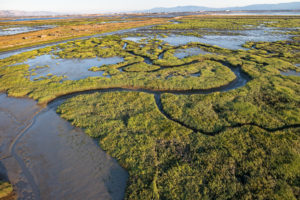Urban creek restoration involves more than removing nonnative plants and substituting local ones. Add to that: volunteer management skills and detailed knowledge of bird, amphibian, fish, and mammal habitats; flood plain control; water quality; government ordinances; and the right size of park benches, bike trails, and trail chips. The list goes on. Susan Schwartz is one of the East Bay’s most active and respected creek restoration leaders. As head of Friends of Five Creeks in the Berkeley/Albany area for the past six years, she describes her role as “weaving green threads into the urban fabric.” She’s also not afraid to talk about the inevitable trade-offs that come with what she prefers to call “revitalization.”
SS: In December 2003, there was a lovely dedication of the revitalization of about 800 feet of Cerrito Creek alongside El Cerrito Plaza shopping center. The native plants were all in; the farmers’ market was busy; dignitaries cut the ribbon. The next day someone tripped over some wood chips after the trail was opened. The City of El Cerrito ordered it closed. Our volunteers came in, removed the old big chips, and put in finer chips, and the trail was reopened.
When the Plaza project began in 2003, the first step was removing a lot of invasive ivy, thereby uncovering a huge rat colony. Complaints came from neighbors saying: There are so many rats all of a sudden. Stories like that are more common than we’d like.
Q: It sounds like there are more variables than you can anticipate, even though you work closely with creek design experts and naturalists of all sorts.
SS: It’s important to listen to experts—they can tell you a lot. But listen to lots of them, so you know how they differ. Ask lots of questions. We’ve had plans done by landscape architects that are as expert as anyone gets in restoration. And sometimes those plans don’t get followed. It’s like remodeling an old house. You run into things you don’t expect and you have to adapt. We try to do some planting the first year, see what works, plant more of that, and add a few other species, to increase biodiversity.
Q: What’s the history of Friends of Five Creeks?
SS: Friends of Five Creeks was founded in Albany in 1996 by private citizens, to restore sections of the five creeks that touch Albany. They are Codornices, Village, Middle, Marin, and Cerrito. We include the tributaries and Schoolhouse Creek. It adds up to maybe 20 miles of waterways—the majority in culverts. All of our projects have totaled less than 3,000 feet of those 20 miles. We have five long-term projects. The citizens of California have recently voted for large water-related bond measures, so we’re lucky that the time has come to do the work.
Q: I know you prefer the term “revitalization” to describe the work you do, rather than “restoration.” Why?
SS: I don’t think it’s useful to think in terms of putting back what used to be. First, the environment is too fluid and too changed. The Bay is only about 10,000 years old, and people have been affecting it all this time. So to which time period are we restoring? Second, if we could restore it, we might not want it. For example, there’s evidence that many of our small creeks didn’t used to have many trees along most of their lower reaches. They regularly flooded large areas and disappeared into wet, mosquito-filled grasslands.
Third, in cities we don’t have the area we need to restore resilient, robust wildlife communities. Small areas are vulnerable to somebody who sprays herbicides or dumps garbage, and species in those areas are vulnerable to cats, rats, dogs, squirrels, raccoons, and seagulls that flourish because of humans. That makes it hard for other species to establish corridors and to get enough space for safe breeding.
Despite the vulnerability, there are really exciting opportunities for wildlife in cities. I’m awestruck by the large numbers of rainbow trout in little Codornices Creek. Before spending more money to improve their habitat, I think we should first figure out how the trout do so well in this degraded little urban creek. My theory is that they survive partly because they can escape the currents in the undercuts of old retaining walls, so we need to think about that before removing those walls.
It would be comforting if there were some model that says, This is restoration. But it’s not the case. What was “right” for the last project may be wrong for this one. We should learn from experience, of course, and I approach each project as an inquiry, an experiment in trying to contribute to imperfect knowledge. So if we’re not restoring, what are we doing? I think we’re revitalizing. We’re giving many forms of life a chance, and giving ourselves a chance to find peace, beauty, solace, wisdom—whatever nature gives us.
I try to think in terms of stewardship—accepting that we are in control, that we can’t return to some natural balance and then walk away. Stewardship implies we have ongoing responsibilities rather than absolute ownership. We need to do the best we can with what isn’t really ours.
Q: Does creek revitalization have benefits beyond the health of the creek itself?
SS: We hope our projects will reduce urban runoff pollution, today’s major source of pollution in the Bay. For example, there’s a large marsh built to treat urban storm water near Coyote Hills in Fremont. It turns out most of the purification is happening upstream, in the cattails and tules on Alameda Creek. These cattails can also shelter eggs, pollywogs, and small fish and keep them from being swept into the Bay. But it’s a trade-off. The cattails are cut for flood control because they form a dense mass of vegetation that slows down water and traps sediment, gradually filling channels. There’s no right or wrong here; there’s no “this is what’s natural.” I urge everyone not to support rigid requirements for planting locally native species, or bans on herbicides or anything else. Probably the most widespread difficulty is that people have a certain “good” that they are pursuing and don’t think about all the other ones.
Q: Given all the difficulties and compromises, what are the payoffs of your work?
SS: It’s pretty wonderful how wildlife tolerates us. We have rainbow trout in Codornices, frogs in Cerrito Creek. We see snakes and hawks and egrets, which means these predators are feeding on lots of smaller critters. All during our last work party, a night heron dozed just across the creek.
All of these questions and trade-offs can be seen as important when we talk among ourselves. But they fade a little when you’re out on a project, working on something life-giving, maybe seeing some fish or a hawk. People stop and say “thank you,” or “it’s coming along,” or “how great it is to see nature coming back.” That’s what counts.
To find out more about the Friends of Five Creeks, visit www.fivecreeks.org.

.jpg)



